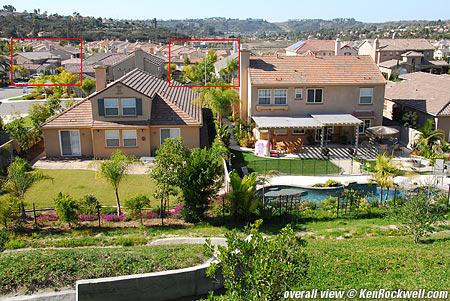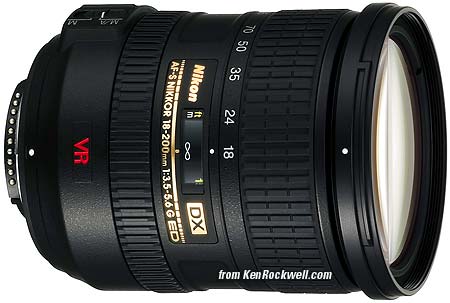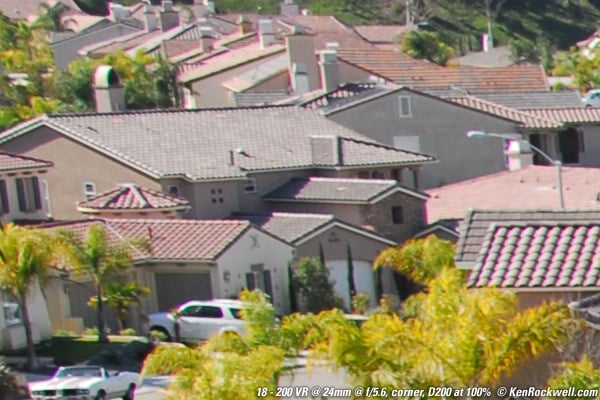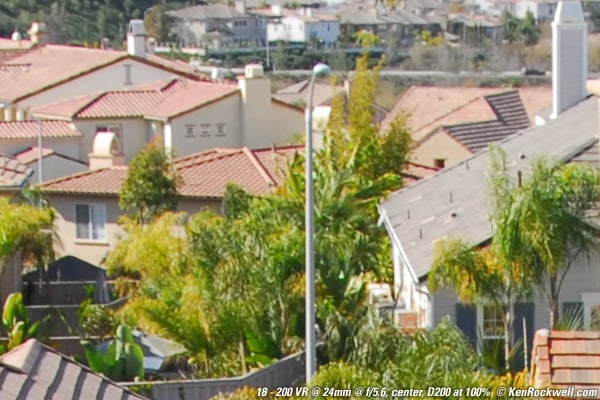|
|
Nikon
18-200mm VR
© 2006
KenRockwell.com
Sharpness
My 18 - 200 is as sharp on my picky D200 as my more expensive and exotic lenses. It looks great. It doesn't go soft at either end of the zoom range or wide open. As I always caution, zoom lenses will vary from one another with production variations, and even vary shot-to-shot and region-to-region due to natural mechanical play.
I've also used four other samples. One was a little less sharp wide open. Otherwise they were all great.
I've made about 10,000 shots with my 18 - 200. I got it and made some initial tests. It looked consistently great, so I've been too busy photographing to bother doing more comparisons.
Of course it gets soft at f/22 due to diffraction. All lenses do that at high resolution.
Hobbyists lose sleep over lens sharpness. Photographers get a new lens, make sure it works, and then worry about making more pictures.
See my examples of what I've shot these past few months with my Nikon 18-200mm and D200. These are notable as they were all shot without a tripod.
Comparisons
Doing comparisons with enough control to mean anything takes time.Too many hobbyists waste too much time worrying and not enough time shooting. Far more important than the last 10% of sharpness is how fast it focuses and how well it handles, unless you and your subjects are dead. Shooting comparisons is bad enough, but you'll go crazy trying to analyze all the permutations. Since lenses vary by sample and by shot, unless you make many, many comparisons between two lenses you aren't getting the entire picture. If they are close like these it's not worth trying to analyze it to death since lens performance can vary shot-to-shot, and if the difference is obvious, it's obvious.
One shot was made an hour and a half later in the day by the time I got to it while making comparison shots among many other lenses. Look at the trees, less effected by the play of light against the walls which makes one look sharper. Trees, as Ansel Adams suggested, make the best test targets, That's because their fractal nature gives them detail at every level of detail in every direction. Test charts usually only have steps of detail, and then they only go in one or two directions. Digital imaging needs radial resolution targets, not linear USAF or others most often used today to test digital cameras. Linear targets are throwbacks to film, which has the same resolution regardless of orientation (diagonal or straight), while digital resolves very differently as you change the angle.
I can make the 18 - 200 look worse than one of my $1,000 lenses if I deliberately rig a test like the one below.
Lenses are usually sharpest stopped down two stops, in the middle of their zoom range, and at moderate to long distances. They are at their worst wide open, at the ends of their zoom ranges and at their closest focus.
Shooting at f/5.6 puts an f/2.8 lens at its sharpest aperture while leaving the 18 - 200 almost wide open. If I do this I can I can see a slight difference at 100%, but that's equivalent to making a 40" wide print and looking at it as close as you are to your screen.
Here's a comparison to my $1,500 17 - 35 mm f/2.8 AF-s which I love for film use. This was shot at f/5.6 and 24 mm on both lenses. The 17 - 35 mm is at peak sharpness because it's stopped down two stops and at the middle of it's zoom range. I'm giving the Nikon 18-200mm the short end in this comparison, since it's only stopped down one stop and it's at the wide end of its range.

Guide image from which the crops are taken.
These are crops at 100% saved-to-web in Adobe Image Ready at 80% quality. A print of the complete image at this size would be 40" (over 1 meter) wide. Would you look at a print that big this close? You'll see even less difference with a lower resolution camera.
Ignore the change in saturation and lighting, which changes minute by minute, as does just about everything. The change in skew is due both to my hand-holding and different distortion characteristics of each lens. Things like exposure also change from shot to shot and I didn't match them region-to-region.
Corner sharpness at 100% on a D200. Roll your mouse over to see the version from the 17 - 35 AF-s.
I see less chromatic aberration in the 17 - 35 and more sharpness in the Nikon 18-200mm. As you're seeing, the lighting conditions in nature change more than the differences between lenses. Considering that my 17 - 35 AF-s is an exotic special purpose zoom double the price of the 18 - 200 and the 18 - 200 is as good, I'll call this a huge win for the 18 - 200. Actually I had to try a couple of times to get this from my 17 - 35; a few other 17 - 35 shots were much worse while the 18 - 200 was consistent.
Center sharpness at 100% on a D200. Roll your mouse over to see the version from the 17 - 35.
Now the 17 - 35 looks a little better. It also has the advantage of better light.
Remember these shots are made in the sweet spot of the 17 - 35 and the weak spot of the 18 - 200. I see little difference. At normal print sizes and viewing distance there is no difference. At smaller apertures I see no difference.
One of these days I'll do the same against my 80 - 200 AFS and use one of my secret stash of radial resolution targets.
MTF Curve
Nikon shares this here.
Sharpness Summary
It's amazing because there's no sharpness penalty for all this flexibility.
I went out of my way to show an example above where a slight difference was visible.






